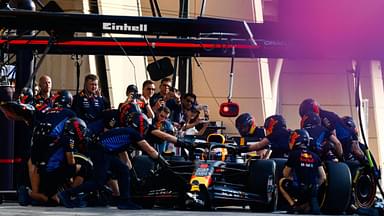In the high-speed sport of F1, communication is key. It could be a matter of life and death. Hence, every means is taken into account when ensuring the right information is communicated to the drivers. One such method is the visual aid of various flags used in racing- each with its own meaning.
Whether it’s an order or a warning, drivers are expected to respond to the flag waved immediately. It is important for drivers to understand the implications of each flag to ensure their safety and the safety of others.
What are the rules under yellow flags in F1?
Most commonly seen during a session, the yellow flag shows the need for caution on the track, typically because of an accident or some debris found on the track. It is also used if a driver has gone off track. Drivers are required to slow down immediately and be prepared to stop if required. Overtaking is not allowed until the green flag is waved.
There are different types of yellow flags- the difference lies in how they are waved. Single-waved yellows order drivers to “reduce your speed, do not overtake and be prepared to change direction” when there is a hazard beside or partially on the track.
Double-waved yellows are more serious. This means “reduce your speed significantly, do not overtake, and be prepared to change direction or stop.” Waving these means there is a hazard wholly or partly blocking the track. Or if marshals are working on or beside the track attending to a pressing issue.
Also read: How A Family Feud Forbade Ayrton Senna’s Girlfriend From Attending His Final F1 Race
They deploy the safety car under double-waved yellow flags to control and guide the drivers on the grid. This means the safety car board is shown to drivers on the track, mandating them to reduce their speeds.
Marshals standing on the trackside can wave yellow flags to caution drivers of local incidents or dangers, usually to drivers who are about to enter that section of the track. It is important for drivers to pay close attention to these flags and signals during a race to ensure their safety and the safety of others on the track.
What are red flags used for?
The ominous red flag symbolises danger and unpredictability in the high-speed world of F1. When this flag is raised, it’s a warning that something serious has happened, and the safety of everyone involved is at risk. Whether it’s a major collision, hazardous track conditions, or severe weather, the red flag signifies that the race or session must be immediately stopped.
For drivers, the red flag is a signal to proceed with extreme caution. They must reduce their speed and carefully navigate their way back to the pit lane, aware that there may be debris or other hazards on the track. The situation is grave, and any wrong move could lead to further accidents or worse.
Once in the pit lane, the drivers must patiently wait for the green light to resume racing. The order of the grid will remain the same, but the stakes are much higher. The drivers and their teams must quickly assess the situation and adjust their strategy accordingly. There’s no room for error, and any mistake could cost them dearly.
Yes, the red flag may disrupt the flow of the race, but it’s necessary to ensure the safety of drivers, marshals, and spectators. In a sport where speed and risk-taking are essential components, the red flag reminds us that safety should always come first. It’s a solemn moment that brings everyone together, emphasizing the need for caution and respect for the sport’s dangers.
Also read: Christian Horner Is Wary of Max Verstappen and Red Bull Underperforming in Coming Races
What does the green flag signify?
Fairly simple, the green flag is waved at the start of the race. It is also brought out to resume a session affected by a yellow or red flag. It acts as a signal of “all clear,” as the session resumes under normal conditions
What is a blue flag in F1?
In the cutthroat world of F1 racing, the blue flag is a critical signal that demands the utmost attention and respect. When a driver is preparing to lap another, the blue flag signals that the backmarker must yield the track as soon as possible. It’s a moment that can make or break a race, and failing to observe the blue flag can lead to serious repercussions.
The rules are clear: If drivers ignore the blue flag three times in a row, they risk getting penalized. And during practice and qualifying rounds, the blue flag warns drivers to move over and let faster cars pass, ensuring fair play among drivers.
But the blue flag is not only a matter of sportsmanship but also safety. In F1, every second counts, and a failure to yield the track to a faster car can cause a serious collision. That’s why the blue flag is one of the most important signals in the sport, demanding attention and respect from drivers, teams, and officials alike.
Why are there black flags and white flags in F1?
The black flag is a rare sight in F1 racing, but it’s a significant signal that commands immediate attention from the driver. It’s used to show a rule violation or safety issue, and the driver must return to the pits immediately upon seeing the flag. The black flag is waved with the driver’s number, making it clear who the accused driver is. This flag results in immediate disqualification.
White flags are used to alert drivers to a slow-moving vehicle ahead, such as a safety car or a heavy service vehicle. They’re also used at the end of practice sessions to signal the drivers that they can practice their race starts from the grid slots to prepare for the race. While they may not be as significant as the black flag, white flags still play an important role in ensuring the safety and fairness of the race.
Also read: Why Fernando Alonso Finishing P3 in Bahrain Is Ominous Sign for Max Verstappen



